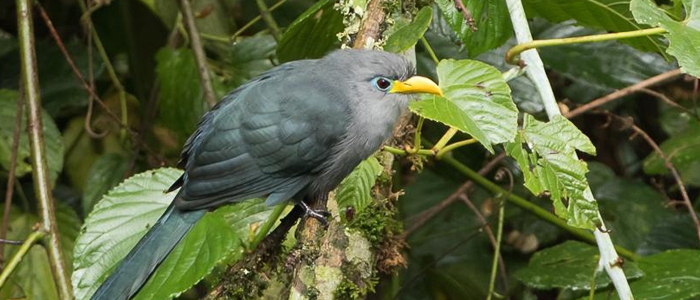

What to Know About the Black and White Casqued in Uganda?
The Black and White Casqued Hornbill in Uganda is one of the African Uganda Birds seen during Birding Safaris in Uganda. The black-and-white-casqued hornbill also known as the grey-cheeked hornbill is found in forests and savannas throughout Uganda, mostly in Murchison falls national park.
How Does the Black-and-white-casqued in Uganda look like?
Black-and-white-casqued hornbills are fairly large, mainly black hornbills with white lower backs and rumps, upper and under tail-coverts, thighs, bellies, and vents.
The central pair of rectrices is all black, while the rest of the tail feathers are black-based and extensively white distally.
The secondaries and inner primaries are mostly white with black bases. This species has grey-tipped facial feathering, which gave rise to another common name, gray-cheeked hornbills.
Males have red eyes, blackish facial skin and a dark brown bill with a high-ridged, laterally flattened casque which has a broad cream-colored base.
Females have a much smaller all-blackish bill, and the casque is reduced to a lower, rounded ridge on the basal upper mandible.
Females have pink facial skin and brown eyes. Males are larger than females, weighing between 1,078 and 1,525 g, while females weigh between 1,000 and 1,250g.
Juveniles emerging from the nest have small bills lacking casques. Birds less than a year of age have brown feathers on the forehead and around the base of the bill.
Subadults have a high degree of vascularization in the area of the future casque. The facial feathers turn from brown to grey by 10 months of age.
How Does the Black-and-white-casqued in Uganda Feed?
Black-and-white-casqued hornbills are mainly frugivorous, with fruit comprising 90% of their diet, 56% belonging to Ficus species.
They forage by hopping from branch to branch in the rainforest canopy and reaching for fruit with the tip of the bill, which they then swallow whole. This species is known to consume over 41 plant genera.
Black-and-white-casqued hornbills also consume birds, eggs, insects, bats, snails, lizards, mollusks, other small animal prey, mosses, lichens, and fungi.
The carnivorous component of the diet is increased while breeding. These hornbills, alone or in flocks, occasionally raid weaver colonies or Egyptian rousette bat roosts and have also been reported feeding on various species of galagos. They are frequently seen foraging alongside monkeys or squirrels.
How Does the Black-and-white-casqued in Uganda Nest?
They commonly nest in naturally formed cavities 9 to 30m high in large rainforest trees. Due to the rarity of these nesting cavities, there is a high degree of intraspecific competition for nesting sites.
In order to protect their nest, pairs seal the cavity with mud pellets collected by the male.
How Does the Black-and-white-casqued in Uganda Breed?
Black-and-white-casqued hornbills are monogamous, breeding seasonally from August to March in eastern Africa.
Their breeding season coincides with local rainy seasons, so they can take full advantage of the abundance of fruit and arthropods at this time.
How Does the Black-and-white-casqued in Uganda Reproduce?
The female lays a clutch of 2 eggs, which are typically 49.3 x 37.4 cm and white in color with pitted shells.
The eggs are incubated for 42 days while the male delivers food to the female hourly through a small slit, regurgitating numerous fruits, mammals, and insects.
The male can bring up to 200 fruits per visit. Usually only one offspring is reared, with the chick from the second-laid egg dying of starvation.
Newly hatched chicks have pink skin and open their eyes at 20 days of age. The offspring fledge in 70 to 79 days and can feed themselves by 40 to 72 days after fledging.
More posts for you

Over 50 excellent reviews on Safaribookings.








